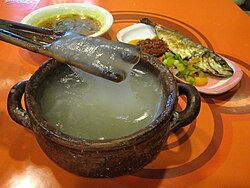Papeda (food)

Papeda served with yellow soup and grilled tude (mackerel) fish
|
|
| Alternative names | Pepeda, Bubur Sagu |
|---|---|
| Course | Main course, staple food |
| Place of origin | Indonesia |
| Region or state | Maluku and Papua |
| Created by | Indonesian cuisine |
| Serving temperature | Hot or room temperature |
| Main ingredients | Sago |
| |
|
Papeda or bubur sagu, is sago congee, the staple food of native people in Maluku and Papua. It is commonly found in eastern Indonesia, as the counterpart of central and western Indonesian cuisines that favour rice as their staple food.
Papeda is made from sago starch. The Moluccans and Papuans acquire the starch by felling the trunk of a sago palm tree, cutting it in half, and scraping the soft inner parts of the trunk, the pith, producing a crude sago pith flour. This flour is then mixed with water and squeezed to leach the starch from the flour. The still moist sago starch is usually stored in a container made of sago palm leaflets, called tumang in which it will keep for several months before spontaneous fermentation will turn it too acidic and unsuitable for making papeda. Depending on the variety and the growing conditions, it may take a sago tree five to fifteen years to accumulate enough starch in its trunk to make the effort of extracting it worthwhile.
Papeda is made by cooking sago starch with water and stirring until it coagulates. It has a glue-like consistency and texture. Papeda is usually eaten with yellow soup made from mackerel, tuna or mubara fish spiced with turmeric and lime. Papeda is sometimes also consumed with boiled starchy tubers, such as those of cassava or yam. Sayur bunga pepaya (papaya flower bud vegetables) and tumis kangkung (stir-fried water spinach) are often served as side dish vegetables to accompany papeda.
Natives of Seram island in Maluku cooking papeda in bamboo.
Using a special wooden fork called gata-gata to separate a serving from the bowl of 'papeda', a glue-like staple dish in West Seram, Maluku, Indonesia.
...
Wikipedia
